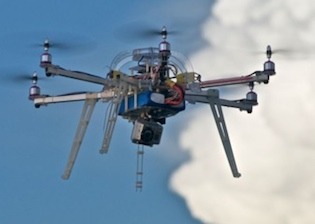What are the rules on drone use right now? What would you use one for in journalism? What about ethics? Last week, the Muck Rack
invited Nebraska Drone Journalism Lab's Matt Waite and
DroneJournalism.org's Matthew Schroyer to a Twitter Q&A on drones to
help answer those questions and more.
Read more on Muck Rack's site, which documented the fourteenth installment of their #muckedup chat.
Reposted from DroneJournalism.org
Showing posts with label Matt Schroyer. Show all posts
Showing posts with label Matt Schroyer. Show all posts
Monday, September 10, 2012
Monday, June 4, 2012
After months of development and heartache, the journalism drone takes flight
Months of planning, training, re-design, and fabrication finally paid off for DroneJournalism.org developers, as we successfully launched a journalism drone for the first time on Sunday, June 3, in the small Illinois town of Tuscola.
Eventually the drone will be equipped with an Arduino-based autopilot (APM 2.0) and cameras to collect aerial photography and aerial photomaps for use in journalism investigations. JournoDrone 2 is the successor to JournoDrone One, which was meant to be a "Unmanned Aerial System (sUAS) for journalists that is powerful, durable, transportable, affordable, upgradeable and supported by a community of experts."
JournoDrone One was smashed to pieces during testing in two months ago. Since then, I had been applying the lessons learned from the first drone to make a drone for journalism that was stronger and more capable.
The June 3 flight was a basic shakedown of the airframe, without autopilot or sensors, to prove the airworthiness of the drone. While the airframe proved slightly heavy and unpredictable at times, our indication is with some modification it will be a competent flyer for our purposes.
JournoDrone 2 is based on the "FPV Raptor" radio controlled airplane with some important modifications, the most important of which is carbon fiber-reinforced fuselage. The airplane had a fairly good track record as a First Person Video drone, so we didn't feel that we needed to change the layout of the craft. Yet we needed to have an extra layer of security to make it more of a "tool" rather than "toy."
While we had some initial concerns about weight gain, the two layers of carbon fiber and epoxy proved its worth when the aircraft experienced a sudden gust of wind in its second flight and crashed. While the impact separated the motor pod, chipped the propeller, bent the motor shaft, and cracked the casing of an on-board camera, the fuselage was totally unscathed. We were not able to recover the on-board video of that second flight.
Tuesday, February 21, 2012
Project JournoDrone: A fixed-wing drone system for journalism
From Dronejounrnalism.org:
Developers at DroneJournalism.org are launching a project to build a low-cost aerial photo platform for journalists, using a combination of off-the-shelf radio-control components and open source electronics. Their goal is to develop a small Unmanned Aerial System (sUAS) for journalists that is powerful, durable, transportable, affordable, upgradeable and supported by a community of experts.
Now one month into the project, development on “JournoDrone One,” or JD-1, is approximately 20 percent complete. DroneJournalism.org is working to secure funding to complete the project by the summer of 2012. The knowledge gained from making and using the drone for aerial photography will allow DroneJournalism.org to bring a similar system to journalists worldwide.
Leading the project is Matthew Schroyer, the founder of DroneJournalism.org, who holds a master’s in journalism from the University of Illinois. Mr. Schroyer has a background in engineering, experience with small, radio-control devices, and experience in using Geographic Information Systems (GIS) for data journalism purposes.
“We hope this is the first of many drones that DroneJournalism.org will develop,” he said. “It’s a practical exercise of existing off-the-shelf drone technology, and our first step into a frontier that could greatly expand public knowledge.”
Developers at DroneJournalism.org are launching a project to build a low-cost aerial photo platform for journalists, using a combination of off-the-shelf radio-control components and open source electronics. Their goal is to develop a small Unmanned Aerial System (sUAS) for journalists that is powerful, durable, transportable, affordable, upgradeable and supported by a community of experts.
Now one month into the project, development on “JournoDrone One,” or JD-1, is approximately 20 percent complete. DroneJournalism.org is working to secure funding to complete the project by the summer of 2012. The knowledge gained from making and using the drone for aerial photography will allow DroneJournalism.org to bring a similar system to journalists worldwide.
Leading the project is Matthew Schroyer, the founder of DroneJournalism.org, who holds a master’s in journalism from the University of Illinois. Mr. Schroyer has a background in engineering, experience with small, radio-control devices, and experience in using Geographic Information Systems (GIS) for data journalism purposes.
“We hope this is the first of many drones that DroneJournalism.org will develop,” he said. “It’s a practical exercise of existing off-the-shelf drone technology, and our first step into a frontier that could greatly expand public knowledge.”
Subscribe to:
Posts
(
Atom
)



